
This post contains some affiliate links. If you make a purchase, Brown Paper Bag may earn an affiliate commission. Learn more here.
This article is brought to you by Brown Paper Stitch, my business that makes your wardrobe pawesome by embroidering your pets on clothing.
There are many ways to transfer an embroidery pattern onto a piece of fabric. You can, for instance, draw on the material using a special pen intended just for embroidery. And while I find that useful for some projects, there’s a transfer method that allows me to turn my design into one big sticker and press it onto the fabric.
Called embroidery stabilizer, this stick-on material is ideal for large projects with a lot of details. To use, I print my pattern on my laser printer and then adhere it to the fabric. Once I’m done, I simply wash the excess pattern away with warm water, and it leaves no trace that it was ever there.
So many people don’t know about this method, and to be honest, I didn’t either—at first. I noticed embroiderers using it a couple of years after I started my stitching. And it was only once I began creating custom pet embroidery—in which I was drawing a sketch for a client—that I considered using it. The big advantage is that you can create a pattern, or use a downloaded one, and just print it without having to transfer using a pen.
How to Use Embroidery Stabilizer
I use Sulky brand Stick N Stitch stabilizer and print my patterns on a laser printer. Once printed, I cut out the designs with a standard pair of scissors and adhere them to my fabric. Once all of my stitching is done, I put the fabric under warm water to remove the stabilizer and let it dry as normal.
Embroidery Stabilizer Tips
Stick and stitch stabilizer is, by far, my preferred method of transferring an embroidery pattern. But, throughout the time I’ve been working with it, I’ve realized it has its quirks. Here are some things you should know before trying it.
- The stabilizer works best with light-colored fabrics. You’ll have an easier time seeing the lines of your design. With dark or black fabrics, you’ll have to strain to see your marks.
- The oils on your fingers can affect the stabilizer. The more you touch the stick and stitch stabilizer, the more you’ll degrade it. Once you’re happy with the placement of the pattern, try not to touch the design unless you’re stitching into it. Repeatedly handling a design can make it harder to see.
- Stick and stitch stabilizer will “shift” and compress your design if you’re not careful. This is an easy problem to prevent. To stop the stabilizer from moving on your fabric, add a few stitches to each corner of your design.
- Stabilizer is like a glue. Once you’ve washed away the stabilizer, it will make your stitches appear a bit less “fuzzy” as the stabilizer is like glue that locks them into place. If you’re embroidering on clothing, this is a great advantage, as it means your stitching will hold up to washings.
